Analys
US shale oil production growth to slow sharply in 2020


Baker Hughes US oil rig count has declined by 178 rigs since the recent peak of 888 rigs in mid-November 2018 with latest count now at 710. If anything the rig count decline has accelerated since July as investors have closed their pockets for debt based production growth with no profit to show for.
US oil rig count is now drawing down by about 3.5% per month. US shale oil producers are now completing more wells than they are drilling. As a consequence the DUC inventory of Drilled but uncompleted wells which ballooned from 5400 wells in late 2016 to a peak of 8246 in March 2019 has now been drawing down since April and is now drawing down at an accelerating pace.
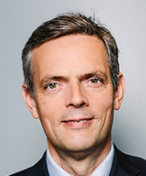
The more the rig count falls the faster will be the DUC inventory draw-down be as producers work hard to maintain the monthly rate of well completions. In the end producers will have no other choice than to reduce the monthly rate of completed wells or to increase drilling activity and that is the point in time when US shale oil production growth will start to slow sharply. We think that in the end a higher oil price is needed to drive drilling activity higher.
If we assume that the drilling rig count continues to fall by 20 rigs per month to the end of this year and then stabilizes then marginal US shale oil production growth is likely to slow sharply from March 2020 before contracting in September 2020.
The US EIA has a very simplistic method of calculating shale oil drilling productivity. The consequence is that they underestimate productivity in periods when the DUC inventory is growing (Dec-2016 to Mar-2019) and overestimate it when the DUC inventory is declining as it has been doing now since April. As a consequence they also have too high production forecasts when the DUC inventory is drawing down like it is now.
The US EIA is now probably overestimating US oil production for 2020 by some 300 k bl/d with a projection that production will average 13.17 m bl/d in 2020 (US EIA STEO report released yesterday). They did reduce their 2020 US production forecast yesterday from 13.23 m bl/d in their September STEO forecast to 13.17 m bl/d yesterday but they are probably still some 300 k bl/d too high.
US shale oil production is still growing by a marginal, annualized pace of 0.9 m bl/d (75 k bl/d/mth) now in October according to the latest US EIA DPR report in September. Thus the current very strong marginal US production growth still gives a very strong bearish impulse to the global oil market. This bearish impulse is however going to slow sharply from March onwards next year and potentially go to neutral and turn to bullish in September next year.
Year on year production growth in the US is still going to be significant in 2020 due to base effects. The US EIA STEO report yesterday projects a US liquids production growth of 1.56 m bl/d y/y from 2019 to 2020. We think that this is probably in the ball-park some 0.3 m bl/d to high. That still leaves a very strong 1.2 m bl/d y/y average growth in 2020. The monthly production growth and thus marginal bearish impulse to the global oil market is however likely going to slow sharply from March next year. On a Jan-2020 to Jan-2021 basis the US crude oil production is probably not going to increase by more than 100 k bl/d unless drilling picks up.
In order to instigate an expansion again in US drilling rig count the shale oil players will need a higher oil price than we have now. The Permian oil price has averaged $56/bl during the oil rig draw-down since January. The WTI price has averaged $57/bl and the 18 month forward WTI price has averaged $55/bl. These prices probably need to move up to $65-70/bl in order to instigate an expansion US shale oil drilling again. Right now we have Permian = $54/bl, WTI 1mth = $53/bl and WTI 18mth = $49.9/bl. I.e. all these prices are today lower than what they have been on average during the rig count draw down since January so further draw down in US oil rig count should be expected.
Ch1: Local Permian oil price in USD/bl versus 4 weeks change in US oil rig count. The Permian oil price has averaged $56/bl during the draw-down phase and probably needs to move up by some $10/bl in order to instigate drilling rig count expansion again. Latest Permian oil price is $54/bl
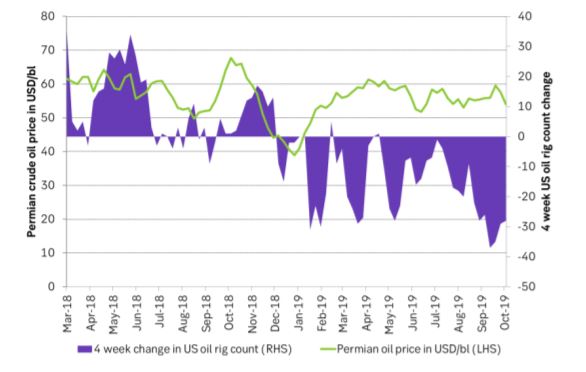
Ch2: The US EIA’s latest STEO report is also forecasting a sharply lower marginal, annualized production growth in US Lower 48 states (excl GOM) which is mostly shale oil production. They are forecasting a marginal, annualized production growth rate of 0.3 m bl/d/yr on average in 2020 versus an average growth rate of 0.84 m bl/d in 2019. Thus the US EIA is also forecasting a sharply slower production growth for US shale next year. However, we do think that their projections are probably too high and needs to be adjusted lower towards zero marginal production growth through 2020.
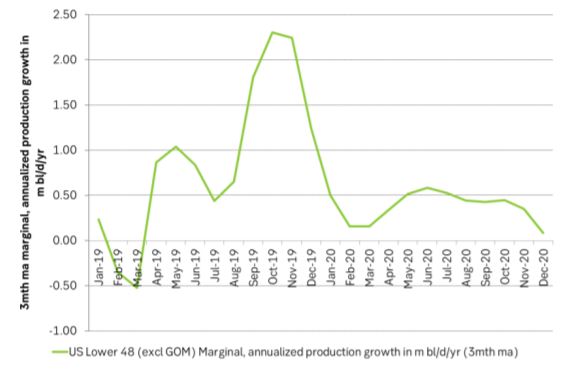
Ch3: US marginal, annualized production growth is still very strong with an annualized growth rate of 0.9 m bl/d according to the US EIA September DPR report. The estimate of 0.9 m bl/d/y for October is probably a bit on the high side. Nonetheless it is in decline. Shale oil players are probably going to start to reduce monthly well completion rates from January onwards as the DUC inventory starts to decline. That will rapidly drive the marginal production growth rate lower
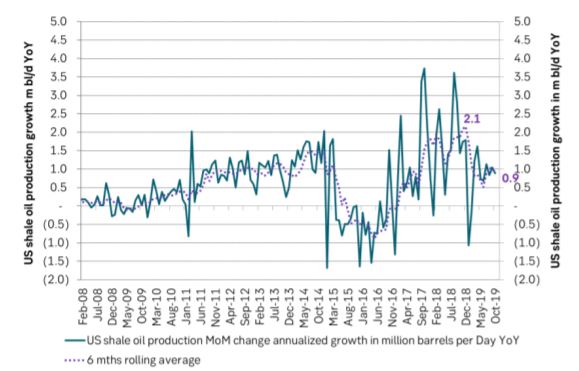
Ch4: The US inventory of DUCs has now been drawing down since April and the draw down is accelerating. It will probably draw down to about 5,500 at around the end of 2020.
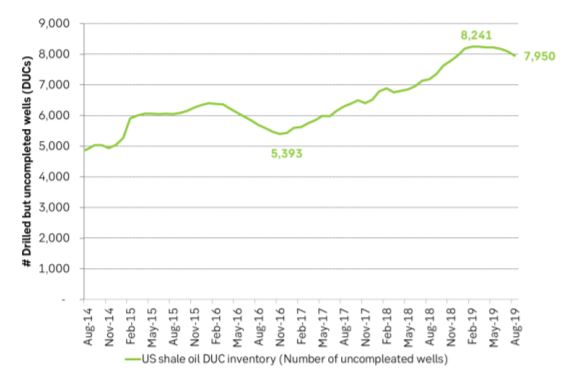
Ch5: US shale oil well productivity has halted its historical relentless productivity growth and has pulled back a little.
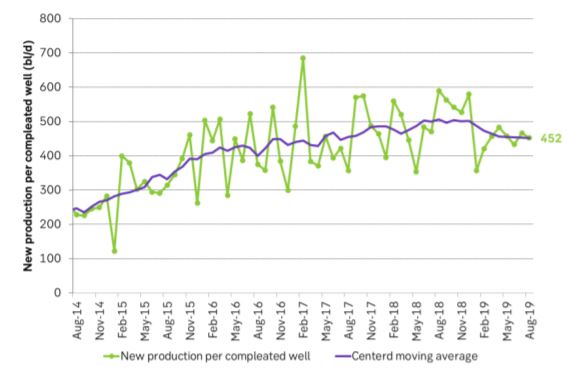
Ch6: Official US EIA drilling rig productivity measure has risen strongly since the end of 2018. In our view this is primarily due to the accelerating draw down in the US DUC inventory which technically is leading to an overestimation in drilling productivity according to the EIA’s methodology of calculating it as [New production at time T]/[Rig count in T-2]. If a significant amount of new production stems for the DUC draw down then production will be high while the rig count number will be low thus leading to an overestimation of the rig productivity
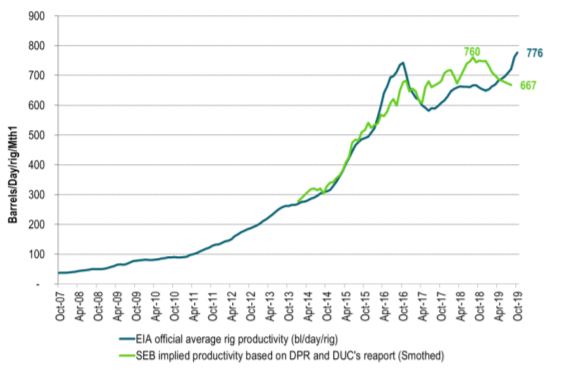
Ch7: US shale oil production is growing strongly but slowing and the slowing will accelerate in March 2020 onwards
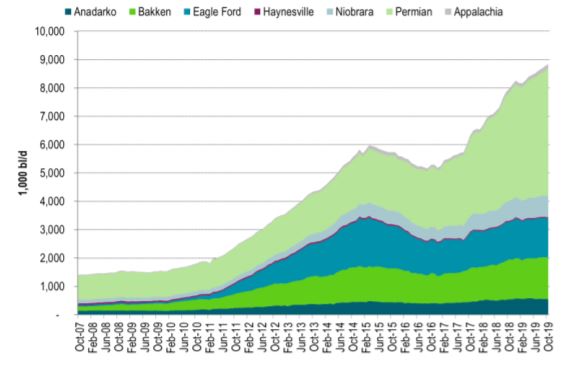
Ch8: US production growth is likely to slow sharply in Q2-2020 onwards as well completions are likely to decline along with the declining DUC inventory
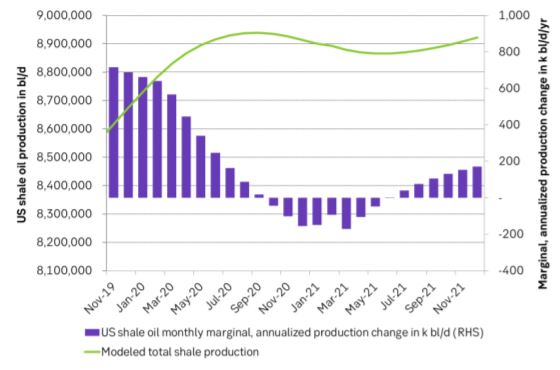
Ch9: US oil rig count is falling sharply and the decline seems to accelerate. Completions of shale oil wells per month has managed to hold up due to the DUC inventory but impact is likely to be significant in Q2-2020 leading in the end to lower well completion rates

Analys
Sell the rally. Trump has become predictable in his unpredictability

Hesitant today. Brent jumped to an intraday high of $66.36/b yesterday after having touched an intraday low of $60.07/b on Monday as Indian and Chinese buyers cancelled some Russian oil purchases and instead redirected their purchases towards the Middle East due to the news US sanctions. Brent is falling back 0.4% this morning to $65.8/b.

It’s our strong view that the only sensible thing is to sell this rally. In all Trump’s unpredictability he has become increasingly predictable. Again and again he has rumbled about how he is going to be tough on Putin. Punish Putin if he won’t agree to peace in Ukraine. Recent rumbling was about the Tomahawk rockets which Trump threatened on 10 October and 12 October to sell/send to Ukraine. Then on 17 October he said that ”the U.S. didn’t want to give away weapons (Tomahawks) it needs”.
All of Trump’s threats towards Putin have been hot air. So far Trump’s threats have been all hot air and threats which later have evaporated after ”great talks with Putin”. After all these repetitions it is very hard to believe that this time will be any different. The new sanctions won’t take effect before 21. November. Trump has already said that: ”he was hoping that these new sanctions would be very short-lived in any case”. Come 21. November these new sanctions will either evaporate like all the other threats Trump has thrown at Putin before fading them. Or the sanctions will be postponed by another 4 weeks or 8 weeks with the appearance that Trump is even more angry with Putin. But so far Trump has done nothing that hurt Putin/Russia. We can’t imagine that this will be different. The only way forward in our view for a propre lasting peace in Ukraine is to turn Ukraine into defensive porcupine equipped with a stinging tail if need be.
China will likely stand up to Trump if new sanctions really materialize on 21 Nov. Just one country has really stood up to Trump in his tariff trade war this year: China. China has come of age and strength. I will no longer be bullied. Trump upped tariffs. China responded in kind. Trump cut China off from high-end computer chips. China put on the breaks on rare earth metals. China won’t be bullied any more and it has the power to stand up. Some Chinese state-owned companies like Sinopec have cancelled some of their Russian purchases. But China’s Foreign Ministry spokesperson Guo Jiakun has stated that China “oppose unilateral sanctions which lack a basis in international law and authorization of the UN Security Council”. Thus no one, not even the US shall unilaterally dictate China from whom they can buy oil or not. This is yet another opportunity for China to show its new strength and stand up to Trump in a show of force. Exactly how China choses to play this remains to be seen. But China won’t be bullied by over something as important as its oil purchases. So best guess here is that China will defy Trump on this. But probably China won’t need to make a bid deal over this. Firstly because these new sanctions will either evaporate as all the other threats or be postponed once we get to 21 November. Secondly because the sanctions are explicit towards US persons and companies but only ”may” be enforced versus non-US entities.
Sanctions is not a reduction in global supply of oil. Just some added layer of friction. Anyhow, the new sanctions won’t reduce the supply of Russian crude oil to the market. It will only increase the friction in the market with yet more need for the shadow fleet and ship to ship transfer of Russian oil to dodge the sanctions. If they materialize at all.
The jump in crude oil prices is probably due to redirections of crude purchases to the Mid-East and not because all speculators are now turned bullish. Has oil rallied because all speculators now suddenly have turned bullish? We don’t think so. Brent crude has probably jumped because some Indian and Chinese oil purchasers of have redirected their purchases from Russia towards the Mid-East just in case the sanctions really materializes on 21 November.
Analys
Brent crude set to dip its feet into the high $50ies/b this week

Parts of the Brent crude curve dipping into the high $50ies/b. Brent crude fell 2.3% over the week to Friday. It closed the week at $61.29/b, a slight gain on the day, but also traded to a low of $60.14/b that same day and just barely avoided trading into the $50ies/b. This morning it is risk-on in equities which seems to help industrial metals a little higher. But no such luck for oil. It is down 0.8% at $60.8/b. This week looks set for Brent crude to dip its feet in the $50ies/b. The Brent 3mth contract actually traded into the high $50ies/b on Friday.

The front-end backwardation has been on a weakening foot and is now about to fully disappear. The lowest point of the crude oil curve has also moved steadily lower and lower and its discount to the 5yr contract is now $6.8/b. A solid contango. The Brent 3mth contract did actually dip into the $50ies/b intraday on Friday when it traded to a low point of $59.93/b.
More weakness to come as lots of oil at sea comes to ports. Mid-East OPEC countries have boosted exports along with lower post summer consumption and higher production. The result is highly visibly in oil at sea which increased by 17 mb to 1,311 mb over the week to Sunday. Up 185 mb since mid-August. On its way to discharge at a port somewhere over the coming month or two.
Don’t forget that the oil market path ahead is all down to OPEC+. Remember that what is playing out in the oil market now is all by design by OPEC+. The group has decided that the unwind of the voluntary cuts is what it wants to do. In a combination of meeting demand from consumers as well as taking back market share. But we need to remember that how this plays out going forward is all at the mercy of what OPEC+ decides to do. It will halt the unwinding at some point. It will revert to cuts instead of unwind at some point.
A few months with Brent at $55/b and 40-50 US shale oil rigs kicked out may be what is needed. We think OPEC+ needs to see the exit of another 40-50 drilling rigs in the US shale oil patches to set US shale oil production on a path to of a 1 mb/d year on year decline Dec-25 to Dec-26. We are not there yet. But a 2-3 months period with Brent crude averaging $55/b would probably do it.
Oil on water increased 17 mb over the week to Sunday while oil in transit increased by 23 mb. So less oil was standing still. More was moving.

Crude oil floating storage (stationary more than 7 days). Down 11 mb over week to Sunday

The lowest point of the Brent crude oil curve versus the 5yr contract. Weakest so far this year.

Crude oil 1mth to 3mth time-spreads. Dubai held out strongly through summer, but then that center of strength fell apart in late September and has been leading weakness in crude curves lower since then.

Analys
Crude oil soon coming to a port near you

Rebounding along with most markets. But concerns over solidity of Gaza peace may also contribute. Brent crude fell 0.8% yesterday to $61.91/b and its lowest close since May this year. This morning it is bouncing up 0.9% to $62.5/b along with a softer USD amid positive sentiment with both equities and industrial metals moving higher. Concerns that the peace in Gaza may be less solid than what one might hope for also yields some support to Brent. Bets on tech stocks are rebounding, defying fears of trade war. Money moving back into markets. Gold continues upwards its strong trend and a softer dollar helps it higher today as well.

US crude & products probably rose 5.6 mb last week (API) versus a normal seasonal decline of 2.4 mb. The US API last night partial and thus indicative data for US oil inventories. Their data indicates that US crude stocks rose 7.4 mb last week, gasoline stocks rose 3.0 mb while Distillate stocks fell 4.8 mb. Altogether an increase in commercial crude and product stocks of 5.6 mb. Commercial US crude and product stocks normally decline by 2.4 mb this time of year. So seasonally adjusted the US inventories rose 8 mb last week according to the indicative numbers by the API. That is a lot. Also, the counter seasonal trend of rising stocks versus normally declining stocks this time of year looks on a solid pace of continuation. If the API is correct then total US crude and product stocks would stand 41 mb higher than one year ago and 6 mb higher than the 2015-19 average. And if we combine this with our knowledge of a sharp increase in production and exports by OPEC(+) and a large increase in oil at sea, then the current trend in US oil inventories looks set to continue. So higher stocks and lower crude oil prices until OPEC(+) switch to cuts. Actual US oil inventory data today at 18:00 CET.
US commercial crude and product stocks rising to 1293 mb in week 41 if last nights indicative numbers from API are correct.

Crude oil soon coming to a port near you. OPEC has lifted production sharply higher this autumn. At the same time demand for oil in the Middle-East has fallen as we have moved out of summer heat and crude oil burn for power for air-conditioning. The Middle-East oil producers have thus been able to lift exports higher on both accounts. Crude oil and condensates on water has shot up by 177 mb since mid-August. This oil is now on its way to ports around the world. And when they arrive, it will likely help to lift stocks onshore higher. That is probably when we will lose the last bit of front-end backwardation the the crude oil curves. That will help to drive the front-month Brent crude oil price down to the $60/b line and revisit the high $50ies/b. Then the eyes will be all back on OPEC+ when they meet in early November and then again in early December.
Crude oil and condensates at sea have moved straight up by 177 mb since mid-August as OPEC(+) has produced more, consumed less and exported more.

-

 Nyheter4 veckor sedan
Nyheter4 veckor sedanOPEC+ missar produktionsmål, stöder oljepriserna
-

 Nyheter3 veckor sedan
Nyheter3 veckor sedanGoldman Sachs höjer prognosen för guld, tror priset når 4900 USD
-

 Nyheter4 veckor sedan
Nyheter4 veckor sedanBlykalla och amerikanska Oklo inleder ett samarbete
-

 Nyheter3 veckor sedan
Nyheter3 veckor sedanGuld nära 4000 USD och silver 50 USD, därför kan de fortsätta stiga
-

 Nyheter2 veckor sedan
Nyheter2 veckor sedanLeading Edge Materials är på rätt plats i rätt tid
-

 Nyheter3 veckor sedan
Nyheter3 veckor sedanNytt prisrekord, guld stiger över 4000 USD
-

 Nyheter4 veckor sedan
Nyheter4 veckor sedanEtt samtal om guld, olja, koppar och stål
-

 Analys4 veckor sedan
Analys4 veckor sedanOPEC+ will likely unwind 500 kb/d of voluntary quotas in October. But a full unwind of 1.5 mb/d in one go could be in the cards








